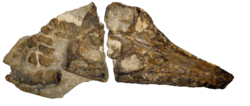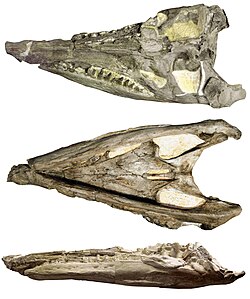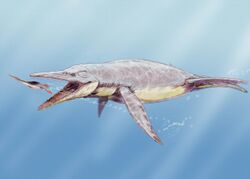Biology:Brachauchenius
| Brachauchenius | |
|---|---|

| |
| Holotype specimen of B. lucasi (USNM 4989) | |
| Scientific classification Error creating thumbnail: Unable to save thumbnail to destination
| |
| Domain: | Eukaryota |
| Kingdom: | Animalia |
| Phylum: | Chordata |
| Class: | Reptilia |
| Superorder: | †Sauropterygia |
| Order: | †Plesiosauria |
| Family: | †Pliosauridae |
| Subfamily: | †Brachaucheninae |
| Genus: | †Brachauchenius Williston, 1903[1] |
| Type species | |
| †Brachauchenius lucasi Williston, 1903[1]
| |
Brachauchenius (meaning 'short neck') is an extinct genus of pliosaurid that lived in North America (United States) and Morocco[2] during the Late Cretaceous.
History
The type species, Brachauchenius lucasi, lived in the Western Inland Sea of North America around 100.5-89.3 million years ago, from the Cenomonian to the Turonian of the Cretaceous. An older specimen from the Barremian of Colombia was considered as part of this genus, representing the first re-occurrence of the non-rhomaleosaurid pliosaurs after a Berriasian-Hauterivian hiatus.[3] However, subsequent analysis of this Colombian specimen shows that it was enough distinctive to warrant a new genus and species, named as Stenorhynchosaurus munozi.[4]
The first known (type) specimen (USNM 4989) was collected by Charles Hazelius Sternberg from Ottawa County, Kansas in 1884.[5][6] It had a skull length of up to 1 m (3.3 ft).[7] The species was named by Samuel W. Williston.[1][8] The individual to which this specimen belongs would have measured 4–5 m (13–16 ft) long.[7] Brachauchenius represents the last known occurrence of a pliosaur in North America.
A larger specimen (FHSM VP-321 - skull length 170 cm) was collected by George Fryer Sternberg in 1952 from the Fairport Chalk of Russell County, Kansas, and later described by Carpenter.[9] Schumacher and Everhart (2005) reported on the age and locality of both Kansas specimens.[10] This specimen is now reassigned to its own genus and species, Megacephalosaurus eulerti.[7]
In 2013, Benson et al. referred a partial cranium from the Chalk Group of England (previously referred to Polyptychodon) to Brachauchenius indet.[11]
In 2015, a pliosaur mandible from Turonian deposits near Goulmima, Morocco were referred to the species Brachauchenius lucasi[2]
Classification
The cladogram below follows a 2011 analysis by paleontologists Hilary F. Ketchum and Roger B. J. Benson, and reduced to genera only.[12]
| Pliosauroidea |
| ||||||||||||||||||||||||||||||||||||||||||||||||||||||||||||||||||||||||||||||||||||||||||||||||||||||||||||||||||||||||||||||||||||
See also
References
- ↑ 1.0 1.1 1.2 Williston SW. 1903. North American plesiosaurs. Field Columbian Museum, Pub. 73, Geological Series 2 (1):1-79. (29 plates)
- ↑ 2.0 2.1 ANGST, D.; BARDET, N. (2015-08-05). "A new record of the pliosaurBrachauchenius lucasiWilliston, 1903 (Reptilia: Sauropterygia) of Turonian (Late Cretaceous) age, Morocco". Geological Magazine 153 (3): 449–459. doi:10.1017/s0016756815000321. ISSN 0016-7568. http://dx.doi.org/10.1017/s0016756815000321.
- ↑ Hampe O. 2005. Considerations on a Brachauchenius skeleton (Pliosauroidea) from the lower Paja Formation (late Barremian) of Villa de Leyva area (Colombia). Fossil Record - Mitteilungen aus dem Museum für Naturkunde in Berlin 8 (1): 37-51.
- ↑ Páramo, María E.; Gómez-Pérez, Marcela; Noé, Leslie F.; Etayo, Fernando (2016-04-06). "Stenorhynchosaurus munozi, gen. et sp. nov. a new pliosaurid from the Upper Barremian (Lower Cretaceous) of Villa de Leiva, Colombia, South America" (in en). Revista de la Academia Colombiana de Ciencias Exactas, Físicas y Naturales 40 (154): 84–103. doi:10.18257/raccefyn.239. ISSN 2382-4980. http://www.raccefyn.co/index.php/raccefyn/article/view/239.
- ↑ Everhart MJ. 2005. Oceans of Kansas - A Natural History of the Western Interior Sea. Indiana University Press, 320 pp. ISBN:0-253-34547-2.
- ↑ Everhart MJ. 2007. Historical note on the 1884 discovery of Brachauchenius lucasi (Plesiosauria; Pliosauridae) in Ottawa County, Kansas. Transactions of the Kansas Academy of Science 110 (3/4): 255-258.
- ↑ 7.0 7.1 7.2 7.3 Schumacher, B. A.; Carpenter, K.; Everhart, M. J. (2013). "A new Cretaceous Pliosaurid (Reptilia, Plesiosauria) from the Carlile Shale (middle Turonian) of Russell County, Kansas". Journal of Vertebrate Paleontology 33 (3): 613. doi:10.1080/02724634.2013.722576. https://www.researchgate.net/publication/263690337.
- ↑ Williston SW. 1907. The skull of Brachauchenius, with special observations on the relationships of the plesiosaurs. United States National Museum Proceedings 32: 477-489. (pls. 34-37)
- ↑ Carpenter K. 1996. A Review of short-necked plesiosaurs from the Cretaceous of the western interior, North America. Neues Jahbruch für Geol. Palaont. Abh. (Stuttgart) 201 (2): 259-287.
- ↑ Schumacher BA, Everhart MJ. 2005. A stratigraphic and taxonomic review of plesiosaurs from the old “Fort Benton Group” of central Kansas: A new assessment of old records. Paludicola 5 (2): 33-54.
- ↑ Benson RBJ, Evans M, Smith AS, Sassoon J, Moore-Faye S, Ketchum HF, Forrest R. 2013. A giant pliosaurid skull from the Late Jurassic of England. PLOS ONE 8(5):e65989 DOI 10.1371/journal.pone.0065989.
- ↑ Hilary F. Ketchum; Roger B. J. Benson (2011). "A new pliosaurid (Sauropterygia, Plesiosauria) from the Oxford Clay Formation (Middle Jurassic, Callovian) of England: evidence for a gracile, longirostrine grade of Early-Middle Jurassic pliosaurids". Special Papers in Palaeontology 86: 109–129. https://www.palass.org/publications/special-papers-palaeontology/archive/86/article_pp109-129.
External links
Wikidata ☰ Q135636 entry
 |




